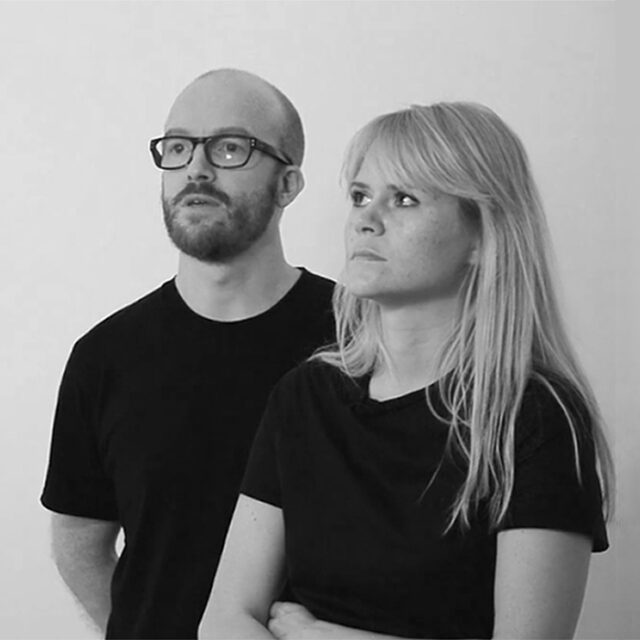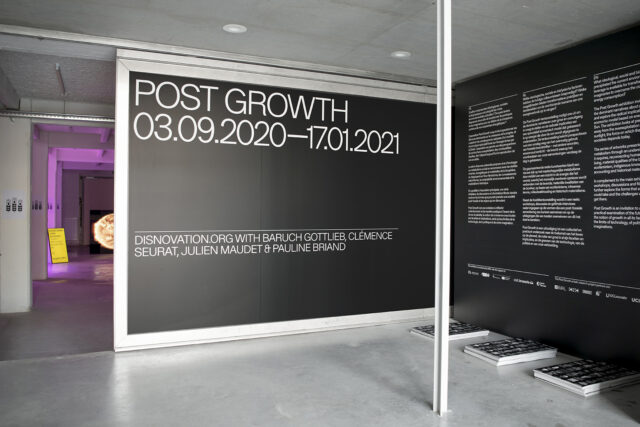← Explore
“Nowadays citizens are not transforming the world around them through the use of their bodies. The primary way we transform the environment and the world around us in the twenty-first century is through prostheses, machines, automation, and computers.”
DISNOVATION.ORG is a working group based in Paris, initiated by Nicolas Maigret and Maria Roszkowska. At the crossroads between contemporary art, research and hacking, the collective develops situations of disturbance, speculation, and debate, challenging the dominant ideology of technological innovation and stimulating the emergence of alternative narratives. Their current exhibition, realized together with Baruch Gottlieb, Clémence Seurat, Julien Maudet, and Pauline Briand at Brussel’s iMAL Art Center for Digital Cultures and Technology, critically examines growth and progress through a series of artworks and filmed interviews with experts in the field.
Q: When and how did you become interested in the concept of post-growth?
A: For the past decade we’ve been looking at the role of techno-solutionism in society. Two years ago, we started to focus on the idea of growth after we began to gather a corpus of conferences, discussions, and texts that revealed a strong correlation between economic growth and the environmental crises we are going through at the moment. Based on this research question we started to meet with academics, activists, writers from a wide diversity of fields of knowledge to see what they could tell us. We quickly realized that not only might two labs be researching the same topic and not know about each other, but that most of the knowledge and concepts we were coming across were almost non-existent online, in journals, public discourse, and so on. We started to think that, as artists, we might have a role to play in linking these knowledges—which seemed to us to be of real use in understanding our current condition and the deep material connection of the environmental and biodiversity crisis we are going through—with the very basic economic and political choices that we are confronted with every day.
Q: How do some of these concepts play out in your exhibition at iMAL?
A: For “Post Growth,” we started to not only document discussions about those concepts through recorded interviews, which became the multi-part series Post Growth Toolkit, but also think about other ways to circulate, activate, and create the space for those ideas to be used, discussed, debated, and criticized. It began to take the shape of game experiments, where we started to design prototypes of games, which we do as a way to circulate and debate and discuss those notions, but it also takes other forms, such as physical or sculptural works that will embody some of the notions that are harder to comprehend in a verbal form. As artists, we can have a strong impact by producing physical instruments that can very clearly demonstrate a complex circumstance, and therefore how it is seen and talked about in society.
Q: Can you give an example?
A: One example is a series of ‘energy slave’ tokens that are included in the show. The work is based on the concept of the energy slave, which was proposed by the American futurist Buckminster Fuller in the 1940s as a notion used to express the energy required to power a modern lifestyle. The concept refers to the technological or mechanical energy equivalent to the physical working capacity of a human adult. In 2020 we have an average of 400-500 energy slaves per living European, which means the lifestyle that we have is the result of about 400-500 times the energy that a single human body can produce. To grasp those orders of magnitude, we started to build bitumen bricks or units of measure that are basically embodying the energy equivalent in fossil fuel of various durations of human labour. We thought that this direction of work was quite eloquent as fossil fuel is the core driver of the global techno-infrastructure. Nowadays citizens are not transforming the world around them through the use of their own bodies. The primary way we transform the environment and the world around us in the twenty-first century is through prostheses, machines, automation, and computers. We recognized that in order to better understand our condition, and what a desirable outcome could look like, it was essential to understand this very material-informed model of how we interact with the world today.



